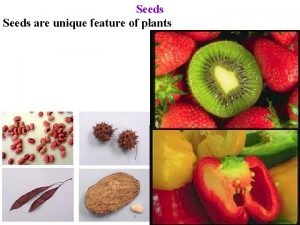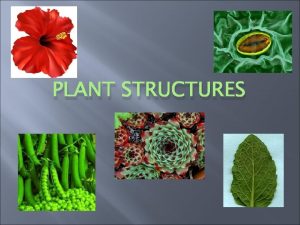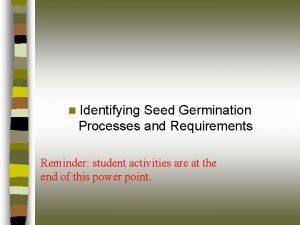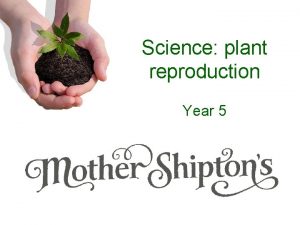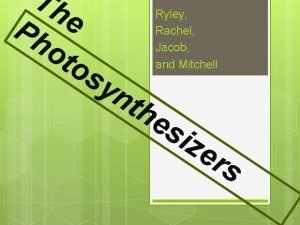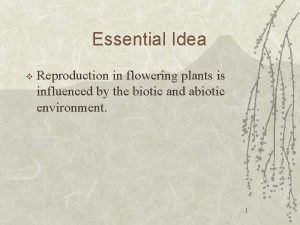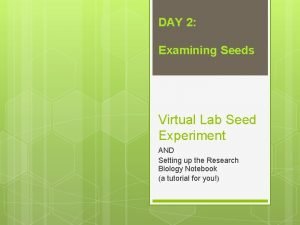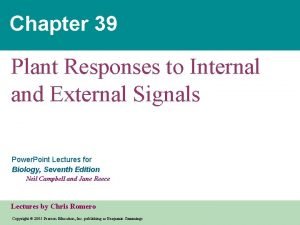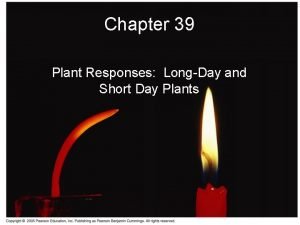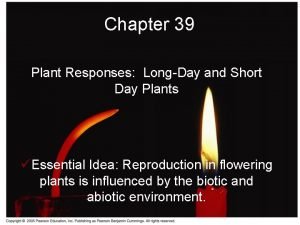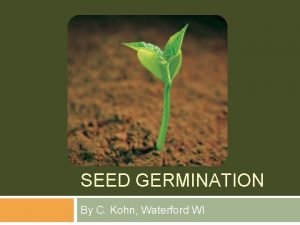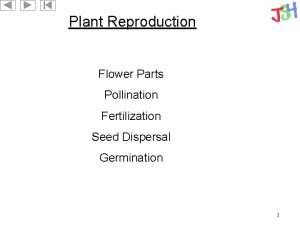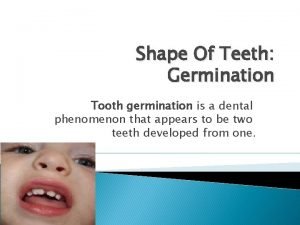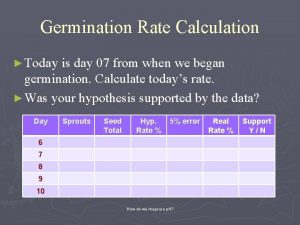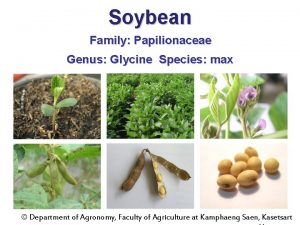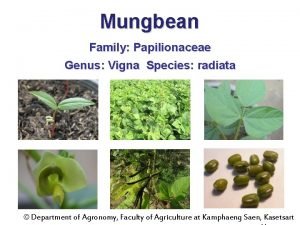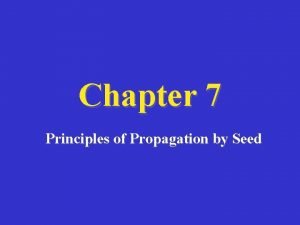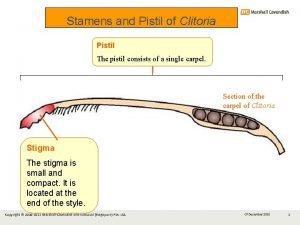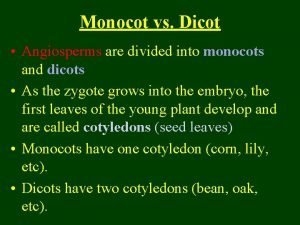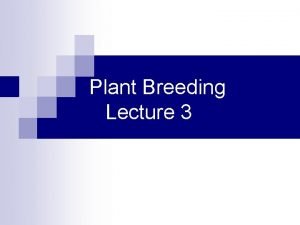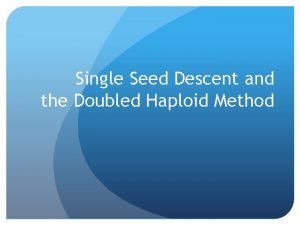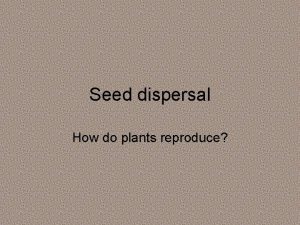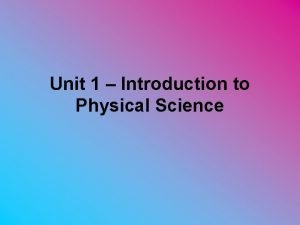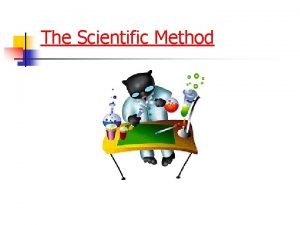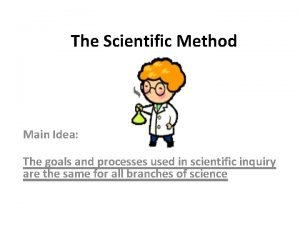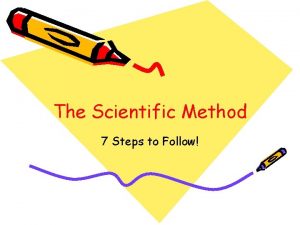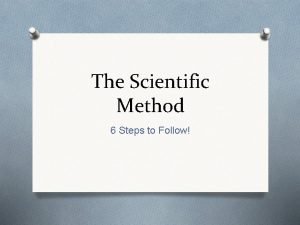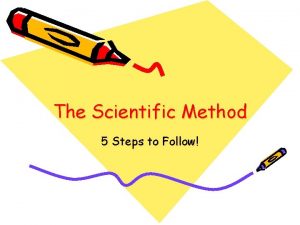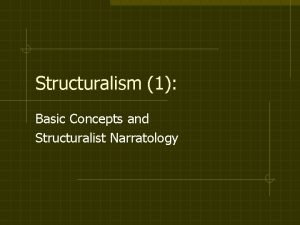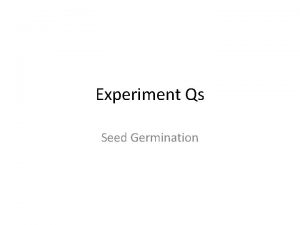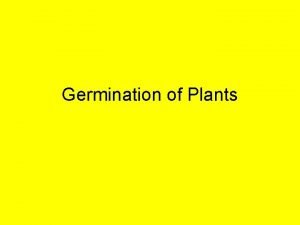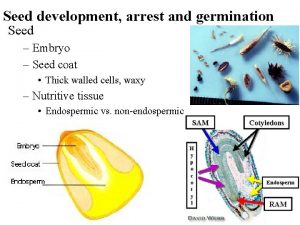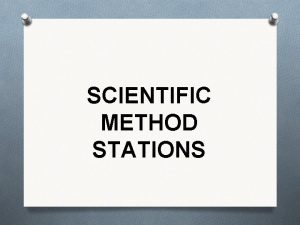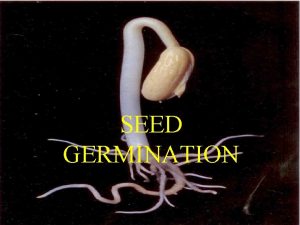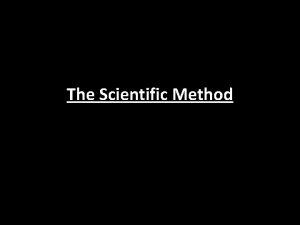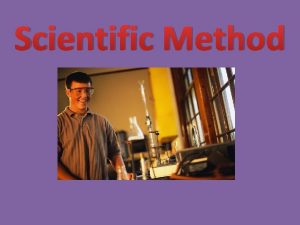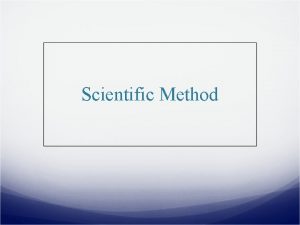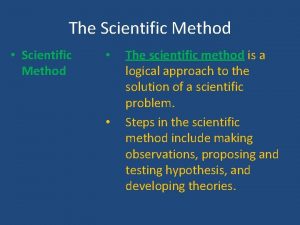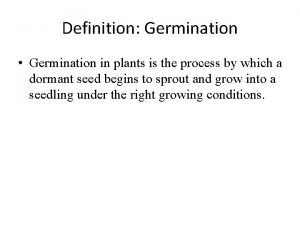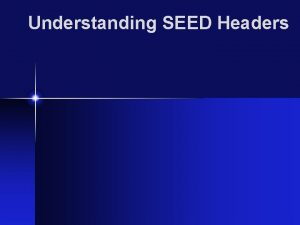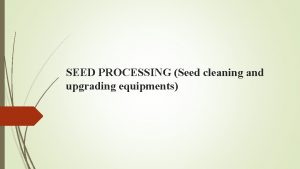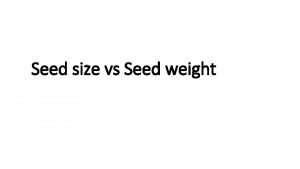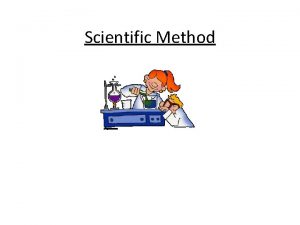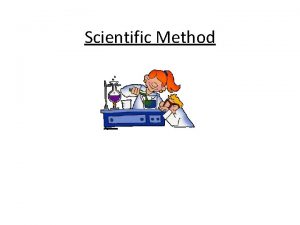Scientific Method Seed Germination What is Science 1













































- Slides: 45

Scientific Method Seed Germination

What is Science • • 1 -S 1. 1 Historical development of science 1 -S 1. 1 Development of scientific explanations 1 -S 1. 2 Judging reliability/relevance 1 -S 1. 3 Scientific explanations 1 -S 1. 4 Theories supported by many individuals 1 -S 1. 3 -5 Experiments 4 -5. 2 Biological research helps with diseases 1 -S 3. 1 Interpreting data leads to further hypotheses & explanations • 1 -S 3. 2 Test experimental data using statistical analysis • 1 -S 3. 2 Analyzing results & formulation conclusions

Do Now: Answer these questions: 1. Where do you find seeds in the plant? 2. What shape are they? 3. What is the purpose of seeds? 4. How big are seeds? 5. What is inside of a seed?

Do Now • Observing seed growth • On a separate sheet of paper write 10 observations of the seeds. • Every day write 5 observations of the seeds.




Mung Beans • Wash 30 mung beans in the petri dish and drain. • Soak them overnight in fresh water in the petri dish. • Drain the soaked beans and place them in a 200 ml beaker and cover with 15 ml water. • Place the petri dish over the opening of the beaker, do not seal the opening. • Change the water once a day. • After several days the sprouts will be plump and long.



Identify and label the parts of your seed.

Draw and label the parts.

Draw and label the parts.

Draw and label the parts.

Draw and label the parts.

Photosynthesis in Bean Plants Illuminating Photosynthesis • http: //www. pbs. org/wgbh/nova/methuselah/phot_flash. html Photosynthesis in plants and a few bacteria is responsible for feeding nearly all life on Earth. It does this by taking energy from the sun and converting it into a storable form, usually glucose, which plants use for their own life processes. Animals that consume plants also make use of this energy, as do those that consume plants, and so on to the top of the food chain. As important a job as making all of the world's food is, there's another vital function that photosynthesis performs: It generates the oxygen that oxygenbreathing animals need to survive. But here we animals repay the favor. We exhale the carbon dioxide that plants need for photosynthesis. This feature takes a look at the oxygen/carbon dioxide cycle and at the process of photosynthesis. Also included are a few puzzlers with answers that may surprise you

Abiotic factors • Abiotic factors (non-living) vary in the environment and determine the types and numbers of organisms that exist in that environment.

Some Abiotic Factors • • light intensity temperature range type of soil or rock p. H level (acidity or alkalinity) • water availability • dissolved gases • level of pollutant • Sooo… • What are abiotic factors? • How do they affect living things?

Limiting factors • Factors which determine the types and numbers of organisms of a species in an ecosystem are called limiting factors. • Many limiting factors restrict the growth of populations in nature. • Limiting factors can be biotic or abiotic.

Plant Dissection Many kinds of flowering plants are commonly subjects for dissection in biology. The flower is the plant structure specialized for reproduction in advanced plants. The processes of meiosis and fertilization occur in the flower. It is a complex structure made from modified stems and leaves, producing pollen in the males, and eggs in the females. Seed: Specialized structure (mature ovule) in gymnosperms and angiosperms that contains the embryo (embryonic sporophyte). Ovule: In seed plants the structure contained in the ovary and develops into the seed.

Plant life cycle

Bean ovule

Beans

Scientific Method Lab • Lets do a lab. • What are the safety precautions we must all follow? ? ?

Problem: How is a scientific method used to solve problems? • Objectives: – forming hypotheses – Interpreting data – Separate and control variables • Materials – – – – 2 88 m. L plastic cups 40 pinto beans ½ tsp salt Water 50 m. L graduated cylinder Ziplock bags Masking tape or lables

First observations: – Make 10 observations of several dry beans. • • • Include length, width and height. Color Smell/odor Hardness Be as observant as you can be. – Write your observations in complete sentences on a separate sheet.

Try to identify the following on your beans? • HILIUM- a small scar where the seed was attached to the parent plant • MICROPYLE- a small pore or hole near the hilium through which the pollen tube grew before the egg within the ovule was fertilized. • In DICOTS, the cotyledons have absorbed the stored food from the endosperm, therefore an endosperm cannot be found. • In MONOCOTS like corn, the food storage takes place in the ENDOSPERM.

Identify and label the parts of your seed.

Your bean is an example of an autotroph. • Green plants and algae are called autotrophs or producer organisms because they make their own food. • They capture solar energy to make sugars (food) in the process of photosynthesis • A producer is any organism capable of making its own food, usually sugars by photosynthesis. • Plants and algae are examples of producers.

How is an Eelgrass seed different from the Bean seed?

Objectives: • This lesson is designed so students get an opportunity to take a close look at seeds- both in the dry, hard state and in the imbibed state, using magnifying lens. • Students will open imbibed seeds to get a look at the embryos: their food source, protective coating, and first leaves. • Students will notice some parts on their own. Other parts will be pointed out. • Students will make drawings of their opened embryos, labeling them with correct terminology. • Students will guess the function of parts, then be given the correct function.

Procedure: • Label 2 beakers A & B. Fill beakers A & B w 50 m. L of water. • Add 10 beans to beaker A. Add 10 beans and ½ tsp salt to beaker B. Label each beaker w your name and set them aside overnight.

Scientific Method Lab • Problem: How is a scientific method used to solve problems? • Forming a hypothesis… – Develop a hypothesis based on the problem.

Day 2 • On the following day, pour the water from both beakers.

The Effect of Salt Water on Pinto Bean Germination (Where did this title come from? ? ? ) • Write 10 observations of the beans treated with pure water. • Write 10 observations of the beans treated with salt water. – Include length width and height. • • Color Smell/odor Hardness Be as observant as you can be. – Write your observations in complete sentences on a separate sheet.

• TESTA- The seed coating which protects the plant embryo and reduces the evaporation of water from the plant; • COTYLEDONS- the first seed leaves that serve as food storage organs for the embryo. They are attached just below the embryo shoot or PLUMULES- leafy structures that will become the plants first true leaves; • EPICOTYL- contains the PLUMULES at the upper end. The lower end will become part of the stem; • HYPOCOTYL- the tougher, thicker part of the embryo. The lower end (the RADICLE) will become the root. The upper end will become part of the stem along with the lower end of the epicotyl.

Procedure • Wrap the seeds from beaker A in a damp paper towel. Place the paper towel into a plastic bag. Label the bag A. • Repeat the last step with the seeds in beaker B.

Day 3 • Check the seeds for growth. Look for small white roots. • Count the number of seeds that are growing in each bag. • Record these numbers in your data table. • Draw conclusions. Based on your data, decide if you need a new hypothesis. • Plant the seeds that are growing.

Complete the data table: Seeds used Water Salt water Seeds that grew

The Effect of Salt Water on Bean Germination: Why does salt kill things? – Dehydration-drawing the water out. • Bacteria in your sore throat is dehydrated. • Plants by the side of the road are dehydrated. • Slugs are dehydrated by mean kids.

Decomposer • Some organisms such as certain pathogenic bacteria may cause disease in other organisms. • Decomposer organisms use the energy of dead organisms for food and break them down into materials which can be recycled for use by other organisms. • Bacteria of decay and many fungi are examples of decomposer organisms.

Questions • Did you see evidence of fungi or bacteria in this experiment? ? • Write a complete sentence to answer this question.

YUCK

Extension: Designing an Experiment • Label 2 beakers A & B. Fill beaker A w 50 m. L of water. • Add 10 beans to beaker A. Add 10 beans and 50 m. L of distilled water` to beaker B. Label each beaker w your name and set them aside overnight. • On the following day, pour the water from both beakers. • Wrap the seeds from beaker A w a damp paper towel. Place the paper towel into a plastic bag. Label the bag A. • Repeat the last step with the seeds in beaker B.

This short movie shows Arabidopsis thaliana seeds germinating in the light. • http: //plantsinmotion. bio. indiana. edu/plant motion/earlygrowth/germination/germ. html
 Dicot seed germination diagram
Dicot seed germination diagram Define seed dormancy
Define seed dormancy Is sunlight necessary for seed germination
Is sunlight necessary for seed germination Conclusion on seed germination
Conclusion on seed germination Dicot seed germination diagram
Dicot seed germination diagram Seed germination diagram
Seed germination diagram Pollination fertilisation seed dispersal germination
Pollination fertilisation seed dispersal germination Rachel ryley
Rachel ryley Conclusion of seed germination
Conclusion of seed germination Angiosperms double fertilization
Angiosperms double fertilization Seed germination virtual lab
Seed germination virtual lab Seed germination
Seed germination Seed germination
Seed germination Seed germination
Seed germination Factors affecting seed germination ppt
Factors affecting seed germination ppt Factors affecting seed germination
Factors affecting seed germination Pistil
Pistil Scientific inquiry vs scientific method
Scientific inquiry vs scientific method Science buddies scientific method
Science buddies scientific method As a child which subjects of science was your favourite
As a child which subjects of science was your favourite Tooth germination
Tooth germination Germination percentage calculator
Germination percentage calculator Hilum
Hilum Family of mungbean
Family of mungbean About germination
About germination Epigenous germination
Epigenous germination Pistil
Pistil Dicot tap root
Dicot tap root How is a scientific law different from a scientific theory?
How is a scientific law different from a scientific theory? Introduction of symposium
Introduction of symposium Single seed descent method
Single seed descent method Single seed descent
Single seed descent Seed dispersal acorn
Seed dispersal acorn Observing and classifying
Observing and classifying Scientific methods in computer science
Scientific methods in computer science K h d m d c m chart
K h d m d c m chart The science of scientific writing
The science of scientific writing 7 steps of the scientific method
7 steps of the scientific method 7 steps of the scientific method
7 steps of the scientific method Scientific method goal
Scientific method goal Brain pop scientific method
Brain pop scientific method 7 steps of scientific inquiry
7 steps of scientific inquiry List 6 steps of the scientific method
List 6 steps of the scientific method What are the 5 steps in the scientific method
What are the 5 steps in the scientific method How does the scientific method work
How does the scientific method work Basic concepts of structuralism
Basic concepts of structuralism


